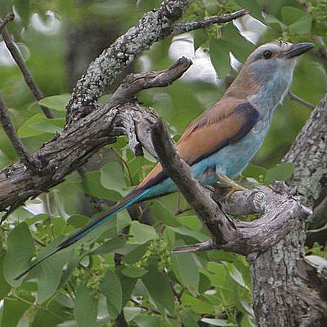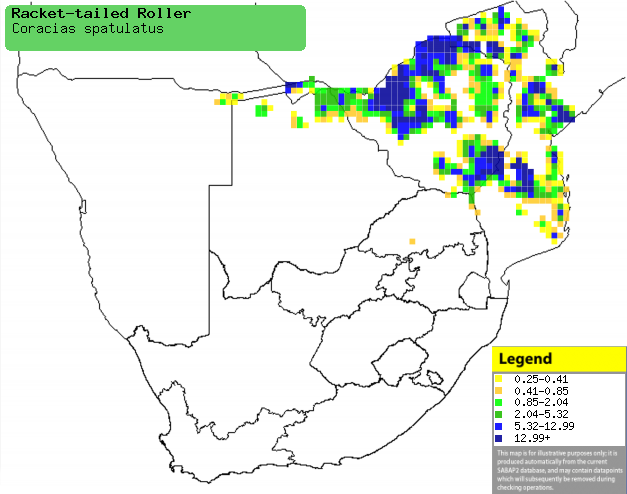|
Coracias spatulatus
(Racket-tailed roller)
[= Coracias spatulata]
Knopsterttroupant [Afrikaans]; Sikambu (generic term for roller)
[Kwangali]; Gatawa (generic name for roller) [Shona]; Vlagstaartscharrelaar
[Dutch]; Rollier à raquettes [French]; Spatelracke [German];
Rolieiro-cauda-de-raquete [Portuguese]
Life
> Eukaryotes >
Opisthokonta
> Metazoa (animals) >
Bilateria >
Deuterostomia > Chordata >
Craniata > Vertebrata (vertebrates) > Gnathostomata (jawed
vertebrates) > Teleostomi (teleost fish) > Osteichthyes (bony fish) > Class:
Sarcopterygii (lobe-finned
fish) > Stegocephalia (terrestrial
vertebrates) > Tetrapoda
(four-legged vertebrates) > Reptiliomorpha > Amniota >
Reptilia (reptiles) >
Romeriida > Diapsida > Archosauromorpha > Archosauria >
Dinosauria
(dinosaurs) > Saurischia > Theropoda (bipedal predatory dinosaurs) >
Coelurosauria > Maniraptora > Aves
(birds) > Order: Coraciiformes >
Family: Coraciidae
 |
|
|
Racket-tailed roller, Kruger National Park, South
Africa. [photo Trevor Hardaker ©] |
|
The Racket-tailed roller is endemic to Africa, occupying an
area from Tanzania to Angola, south to Zimbabwe Botswana and Mozambique. It
prefers mature undisturbed deciduous woodland, especially Miombo, Mopane and
Zambezi Teak woodland. Its diet is little known, but it is thought to feed
mainly on insects, hunting from low perches, swooping to catch prey once
spotted. It is probably a cooperative breeder, nesting in tree cavities about
6-7 m above ground, either natural or excavated by large woodpeckers. There is
little more information about its breeding habits, as there have been no large
studies done on this species.
Distribution and habitat
Occurs from Tanzania, southern DRC, Angola and Zambia to
southern Africa. Within southern Africa it is uncommon to fairly common in the
Caprivi Strip (Namibia), northern Botswana, Zimbabwe, Mozambique and Limpopo
Province. It generally prefers mature, undisturbed deciduous woodland, especially
miombo (Brachystegia),
Mopane (Colosphermum mopane) and Zambezi teak (Baikiaea plurijuga) woodland.
|
 |
|
Distribution of Racket-tailed roller in southern
Africa, based on statistical smoothing of the records from first SA Bird
Atlas Project (©
Animal Demography unit, University of
Cape Town; smoothing by Birgit Erni and Francesca Little). Colours range
from dark blue (most common) through to yellow (least common).
See here for the latest distribution
from the SABAP2. |
Food
Its diet is little known, but it is
thought to feed mainly on insects. It typically hunts from a low perch, pouncing
on any prey items it spots. The following food items have been recorded in its diet:
Breeding
- Probably a cooperative breeder, as breeding pairs are sometimes observed
with non-breeding adults, who are likely to be helpers
- Nests in tree cavities about 6-7 m above ground, either natural or
excavated by large woodpeckers.
- It lays 2-3 eggs in the period from about September-December;
egg-laying typically peaks in October.
- The incubation of the eggs and caring of the chicks has not been
studied.
Threats
Status uncertain, but it is probably threatened by the destruction of deciduous woodlands.
References
-
Hockey PAR, Dean WRJ and Ryan PG (eds) 2005. Roberts
- Birds of southern Africa, VIIth ed. The Trustees of the John Voelcker
Bird Book Fund, Cape Town.
|
